|
|
Post by another specialist on Jul 18, 2007 18:16:44 GMT
Perhaps, but this stuffed specimen is already about 100 years old, it lived at a time when there were also thylacines and all the other creatures which survived even in the early 20th century. I don´t know how big the chances are, that there are still big cats in Turkey. The change is very big. They were heard in 2004, and at the end of this year (2005) the researchers will go back, with the reasonable hope to rediscover the Caspian tiger. And hopefully also the Anatolian leopard. The researchers are very hopeful. I've e-mailed with the author of the following article: "Can, O.E. 2004. Status, Conservation and Management of Large Carnivores in Turkey. Council of Europe. 29 pages. Strasbourg, France". See also these threads: The Status of the Caspian Tiger in Turkey, and Caspian Tiger |
|
|
|
Post by another specialist on Jul 18, 2007 18:17:32 GMT
Caspian Tiger rediscovered in Turkey? The following excerpts are taken from "Can, O.E. 2004. Status, Conservation and Management of Large Carnivores in Turkey. Council of Europe. 29 pages. Strasbourg, France". "Earlier in the 20th century, the presence of the Caspian tiger had been known by Turkish (Turkish Republic Official Gazette, 1937). Yet, when the Caspian tiger was declared Extinct in the world, international zoologists did not accept the idea that the Caspian tiger distribution range extended as far as eastern Turkey (Dr. George Schaller, Ankara, Turkey, personal communication, 2003). In fact, the species was officially a pest species until 11th July 2004 in Turkey. In the 1970s, surveys conducted by Paul Joslin in Iran turned up no signs of the Caspian tiger and the conclusion was made that the Caspian tiger had been extirpated. International cat experts only became aware of the presence of the Caspian tiger in Turkey after a tiger was killed in Uludere, Þõrnak 1970 (Uludere was a sub-province of Hakkari in 1970). Three years later, a botanist visiting the area saw and photographed the tiger pelt and published the story (Baytop, 1974)." Turkish scientists, during a study on the field, reached some information on the presence of the Caspian Tiger. "Within the framework of Southeastern Anatolia Biodiversity Research Project of WWF-Turkey, a survey was conducted to reveal the large mammal presence and distribution in the region (Can & Lise, 2004). Within the framework of the first attempt to collect systematically the large mammal data in Southeastern Turkey. First, a questionnaire was designed and distributed to 450 military posts in the region. The questionnaire included questions about the presence of large mammal species and each questionnaire were accompanied with Turkey's Mammal Poster of Turkish Society for the Conservation of Nature (which became WWF-Turkey later). The questionnaires were filled out by military personnel in cooperation with the local people and 428 questionnaires were returned to WWF-Turkey. The questionnaires also included questions related with the historical tiger presence in the region. Later, the questionnaire results were used to identify the areas that the field survey will focus. In the questionnaire results, some military personal had presented rumours about the presence of large cats in the region. Moreover, during the interviews with local people, the mammal team collected rumours about big cat sightings and met local people that claimed to hear roaring from different sites. In addition, it was reported that there was a local tiger pelt trade in the region and three to five tigers were killed in each year and the pelts were sold to rich land lords in Iraq until mid-1980s. This also confirms Turan (1984) who has obtained his information from local hunters in the region. Baytop (1974) similarly reported that 1-8 tigers were killed each year in Þõrnak region. Considering that, one to eight tigers were killed each year in Eastern Turkey until the mid 1980s, the tiger that was killed in Uludere was a young individual according to the stripe patterns, the Caspian tiger is likely to have existed in the region at least until the early 1990s. Nevertheless, due to mainly lack of interest in addition to security and safety reasons trained biologists had not attempted to survey in Eastern Turkey before." It does not prove that the Caspian Tiger survived, but the researchers think they should investigate it seriously. They will give the start for such an investigation probably in 2005. |
|
|
|
Post by Melanie on Sept 10, 2007 20:59:29 GMT
|
|
|
|
Post by Melanie on Sept 11, 2007 10:37:45 GMT
|
|
|
|
Post by another specialist on Sept 11, 2007 18:50:48 GMT
|
|
|
|
Post by temujin on Sept 13, 2007 15:43:34 GMT
Reading about the presence of the Caspian tiger in southwest Siberia,i thinked one thing:
Both Caspian and Siberian tiger are know for travel great distances.The
Siberian tiger was seen in some times in the late XIX century in areas west of the Baikal lake.And the Caspian tiger was seen near Barnaul and in the Irtysh and Ob rivers in Western Siberia in the same century.Thus,i thinked in the possibility of the existence of a frontier(even if it wasn't fix) between the two subspecies.What do you think about this??.
|
|
|
|
Post by another specialist on Sept 13, 2007 18:47:42 GMT
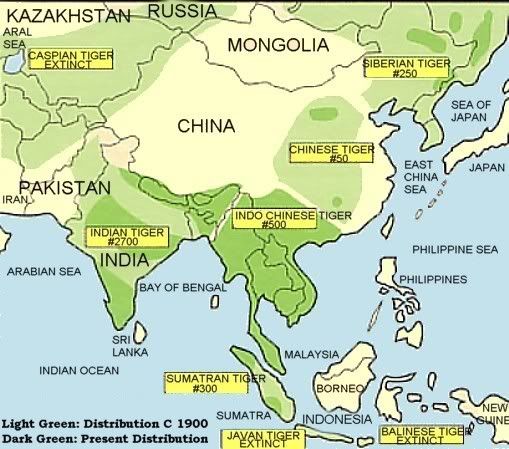 Just to show distribution of all tiger subspecies |
|
|
|
Post by another specialist on Apr 8, 2008 11:08:34 GMT
|
|
|
|
Post by another specialist on Apr 8, 2008 11:09:55 GMT
|
|
|
|
Post by another specialist on Apr 8, 2008 11:47:43 GMT
|
|
|
|
Post by another specialist on Apr 8, 2008 11:55:57 GMT
|
|
|
|
Post by another specialist on Apr 8, 2008 12:00:22 GMT
|
|
|
|
Post by another specialist on Apr 8, 2008 12:09:31 GMT
larger images of above www.lairweb.org.nz/tiger/caspian3.html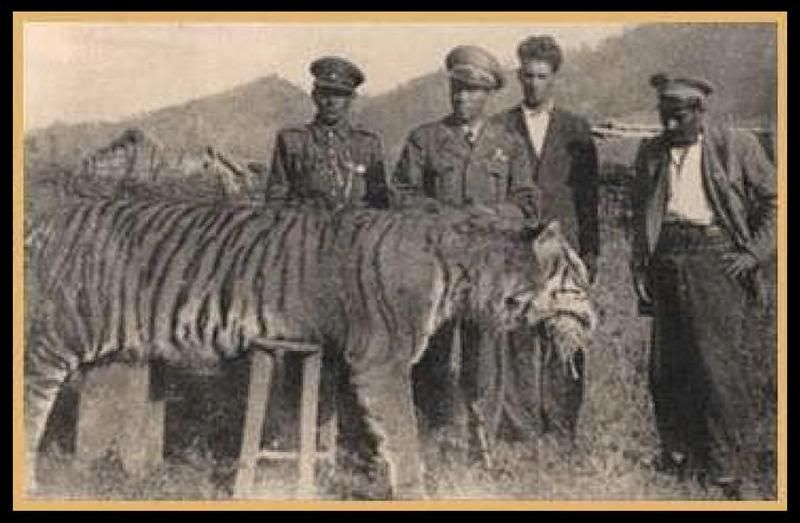 Image 1--This Caspian tiger was killed in Northern Iran. The photograph dates from the early 1940’s. 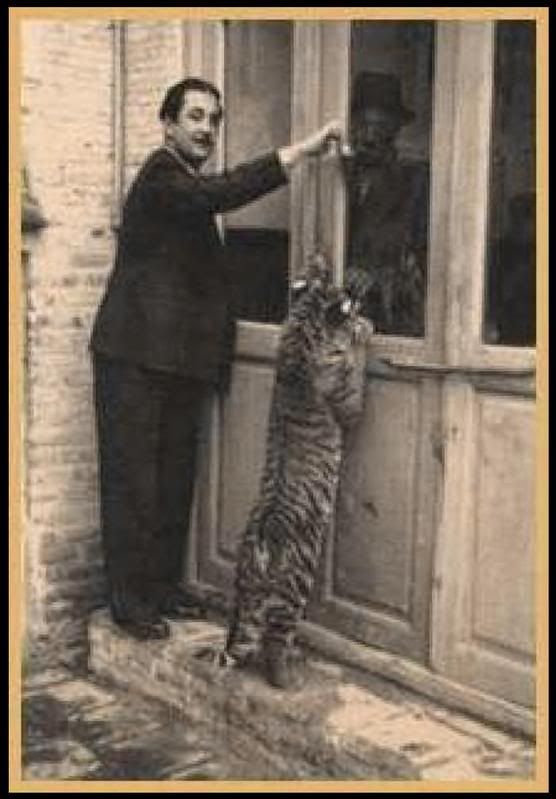 Image 2--This picture shows the Afghani Prince, Ayoub Khan, with a tiger cub given to him as a gift from the Persian Ghajar Prince, Gheisar Massoud, grandson of Nasser-edin Shah. The photograph was taken at Prince Ayoub Khan's residence in Tehran, Iran. He was later crowned King of Afghanistan.  Image 3--A preserved Caspian tiger at the Medical College in Baku, Azerbaijan. |
|
|
|
Post by another specialist on Apr 8, 2008 12:16:43 GMT
|
|
|
|
Post by another specialist on Apr 8, 2008 12:34:45 GMT
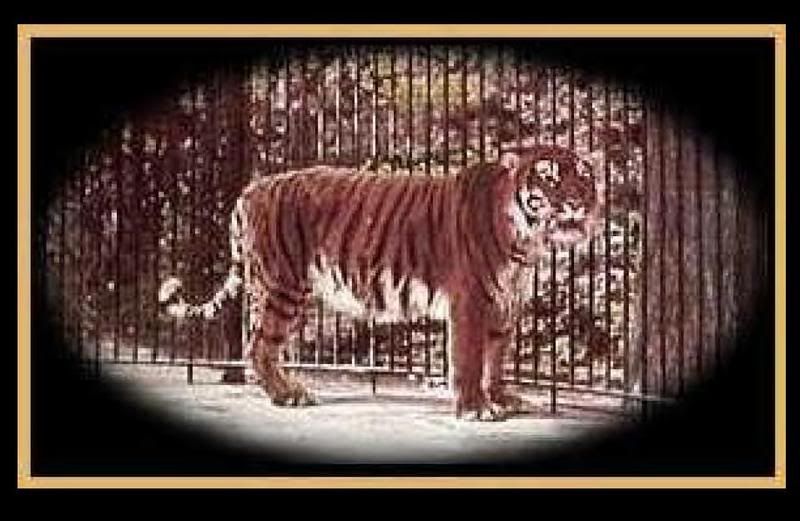 Image 1--This photograph is found widely across the Net. There is some debate about whether or not it is a colourised image and where it was taken, something which is not unusual when it comes to old tiger photographs. The favourite opinion is that it was taken in the late 1800s, probably at Berlin Zoo. Along with this usually comes the suggestion it has been colourised. Other people correctly point out that early colour pictures from Russia were very dodgy by Western standards and place the photograph as having been taken in 1950, probably in Moscow. 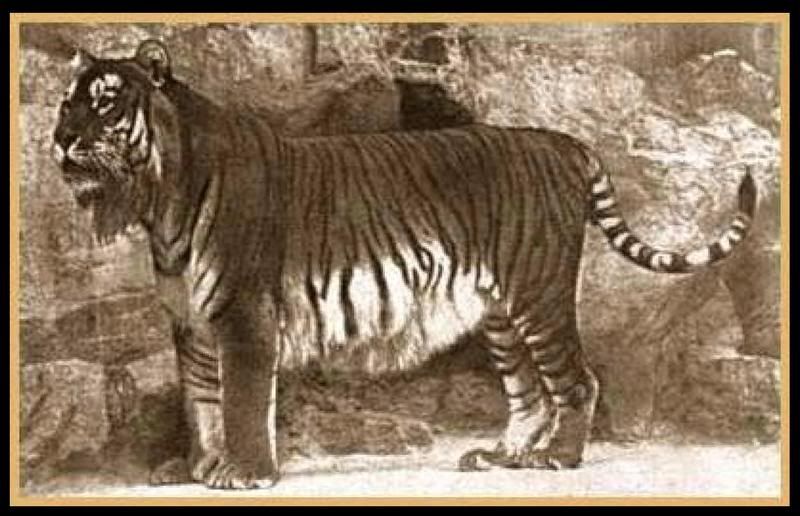 Image 2--The bottom black and white photograph was taken in 1899 and shows a captive Caspian at the Berlin Zoo. www.lairweb.org.nz/tiger/caspian.html |
|
|
|
Post by another specialist on May 22, 2008 17:26:53 GMT
|
|
|
|
Post by temujin on May 23, 2008 4:09:35 GMT
In a ancient maganize that i buyed some days ago about Big Cats there was a map of the distribution of the tiger.That map showed the range of the Caspian tiger extending in all of the Caspian Sea coast,almost all of Caucasus and Kalmykia,reaching in north as far the middle Volga,in the outskirts of the ancient city of Sarai Berke(the second capital of the Blue/Golden Horde) and the actual Volgograd(former Tsaritsyn and Stalingrad) and almost all of the Ural Basin(know as the Iaik River until 1775),including the area of the ancient city of Sarayjük(capital of the Nogai Horde) and the actual Aterau.Further east shows also his habitat extending as far southweast Siberia,in the Altai Mountains area(Republic of Tuva) and the Upper Ob and Irtysh,nearly boarding with the Siberian tiger.And in the south shows also a frontier with the Bengal tiger in the nowday Pakistan.
|
|
dp43
Junior Member
 
Posts: 5
|
Post by dp43 on Jul 17, 2008 14:13:22 GMT
I am curently working in the Sulaymaniyah Region of Kurdistan (Eastern region close to the Iranian boarder), and was talking to a gentleman who claims his Uncle shot a Caspian Tiger 10 years ago. This was self defence not hunting as a small child was at risk also.
The skin was preserved and is located in the Sulaymaniyah museum, I am going to check tomorrow.
However the point of this post is that the man in question claims the Tigers are seen in the mountains close by during the winter. They come to feed on the sheep and goats. It is the custom here to store winter fodder in trees/bushes for the sheep and goats.
I would be interested to hear any views those with some subject knowledge have on the matter.
|
|
|
|
Post by Melanie on Jul 17, 2008 14:23:04 GMT
This reminded me on the people who talk stories about big foots and moas which they have seen in recent years. So i would give nothing to such stories from people which only intension it is to came into the media. By the way the guy who allegedly have photographed the Chinese tiger last year was unmasked as lyer. I am curently working in the Sulaymaniyah Region of Kurdistan (Eastern region close to the Iranian boarder), and was talking to a gentleman who claims his Uncle shot a Caspian Tiger 10 years ago. This was self defence not hunting as a small child was at risk also. The skin was preserved and is located in the Sulaymaniyah museum, I am going to check tomorrow. However the point of this post is that the man in question claims the Tigers are seen in the mountains close by during the winter. They come to feed on the sheep and goats. It is the custom here to store winter fodder in trees/bushes for the sheep and goats. I would be interested to hear any views those with some subject knowledge have on the matter. |
|
dp43
Junior Member
 
Posts: 5
|
Post by dp43 on Jul 17, 2008 14:35:19 GMT
We were talking in a cement factory about a completly different subject and this gentleman has NO media interest whatso ever. It was a casual line in a conversation, like I said I'll have a look in the museum tomorrow (Friday prayers permitting).
|
|